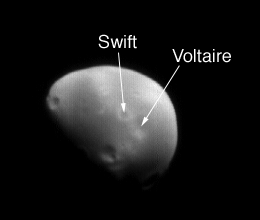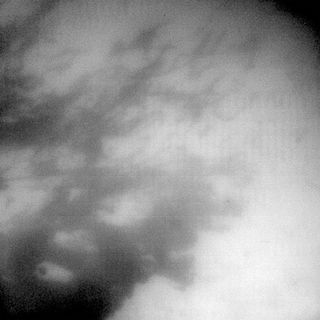
Pwyll is an impact crater on the surface of Jupiter's moon Europa. It is thought to be one of the youngest features on the moon. The crater was first observed from Voyager images in 1986, and the name was officially recognized by the IAU in 1997, after Pwyll of Welsh mythology.

Canso is a Martian crater. It lies about 450 kilometres west of the Viking 1 lander, slightly northeast of Lunae Planum, and west of Chryse Planitia, in the Lunae Palus quadrangle. The crater is named after Canso, a fishing town in Nova Scotia. The name was officially adopted in 1988 by the International Astronomical Union's Working Group for Planetary System Nomenclature (IAU/WGPSN).

Kittu crater is a crater on Jupiter's moon Ganymede. It is approximately 15 km (9.3 mi) in diameter.

Neith crater is a crater on Jupiter's moon Ganymede, the largest moon in the solar system.

Odysseus is the largest crater on Saturn's moon Tethys. It is 445 km across, more than 2/5 of the moon's diameter, and is one of the largest craters in the Solar System. It is situated in the western part of the leading hemisphere of the moon—the latitude and longitude of its center are 32.8°N and 128.9°W, respectively. It is named after the Greek hero Odysseus from Homer's the Iliad and the Odyssey.
Gaea is an impact crater on Amalthea, one of the small moons of Jupiter. The crater is 75 km wide and at least 10–20 km deep. Its center coordinates are 50°S, 95°W. Gaea is one of two named craters on Amalthea, the other being Pan. It is named after the Greek goddess Gaia.

Lyctos Facula is a bright mountain on one of Jupiter's smallest moons Amalthea. It is believed to have a width of 25 kilometers and height of 20 kilometers, almost two and a half times higher than Mt. Everest . It is one of two named faculae that appear on Amalthea, the other being Ida Facula. It was discovered by Voyager 1 in 1979 and in the same year named for the region of Crete in which Zeus was raised. Firstly it was named simply Lyctos.

Ida Facula is a bright mountain on Amalthea, one of Jupiter's smallest moons. It is known to be about 15 kilometers in width, somewhat smaller than the neighboring mountain Lyctos Facula. It was discovered by Voyager 1 in 1979 and in the same year named for Mount Ida, a mountain in Crete where Zeus played as a child. Firstly it was called simply Ida.

Arcas is a crater on Jupiter's moon Callisto measuring 60 km (37 mi) across. It is an example of a central pit impact crater. A smaller crater near Arcas is called Ginandi. The crater is named after Arcas, the son of Callisto in Greek mythology.

Swift crater is a crater on Mars's moon Deimos. It is about 3 km (1.9 mi) in diameter. Swift crater is named after Jonathan Swift, whose 1726 book Gulliver's Travels predicted the existence of two moons of Mars. Swift crater is one of two named features on Deimos, the other being Voltaire crater. On 10 July 2006, Mars Global Surveyor took an image of Deimos from 22,985 km (14,282 mi) away showing Swift crater.

Galileo Regio is a large, dark surface feature on Jupiter's moon Ganymede.

Gertrude is the largest known crater on Uranus's moon Titania. It is about 326 km across, 1/5 of Titania's diameter. It is named after the mother of Hamlet in William Shakespeare's play Hamlet. Features on Titania are named after female Shakespearean characters.

Hamlet is the largest crater on the known part of the surface of Uranus' moon Oberon. It has diameter of about 206 km and is named after the title character of the play Hamlet, by William Shakespeare. The crater has a dark floor and is surrounded by a system of bright rays, which are ice ejecta deposited during the impact event. The nature of the dark material on the floor is unknown, but it may have erupted from the depth through cryovolcanism. The crater was first imaged by the Voyager 2 spacecraft in January 1986.

Persbo Crater is an impact crater in the Elysium quadrangle of Mars located at 8.54° N and 203.24° W. It measures 19.5 kilometer in diameter and was named after Persbo, Sweden. Impact craters generally have a rim with ejecta around them, in contrast volcanic craters usually do not have a rim or ejecta deposits. As craters get larger they usually have a central peak. The peak is caused by a rebound of the crater floor following the impact.

A palimpsest, in planetary astronomy, is an ancient crater on an icy moon of the outer Solar System whose relief has disappeared due to creep of the icy surface or subsequent cryovolcanic outpourings, leaving a circular albedo feature, perhaps with a "ghost" of a rim. Icy surfaces of natural satellites like Callisto and Ganymede preserve hints of their history in these rings. A typical example is Memphis Facula on Ganymede, a 340 km wide palimpsest.

Sharonov is an impact crater in the Lunae Palus quadrangle of Mars, located at 27.3°N 301.5°E. It is 100.0 km (62.1 mi) in diameter and was named after Vsevolod V. Sharonov, a Russian astronomer (1901-1964). Sharonov is situated within the outflow channel system Kasei Valles, whose flows were divided into two main branches that bracket the crater.

Several bright surface features were discovered on the dwarf planet Ceres by the Dawn spacecraft in 2015.

Occator is an impact crater located on Ceres that contains "Spot 5", the brightest of the bright spots observed by the Dawn spacecraft. It was known as "Region A" in ground-based images taken by the W. M. Keck Observatory on Mauna Kea.

The Santorini Facula is a facula on the surface of Titan, around a 40 km wide impact crater. It was named after the Greek island Santorini in 2006.


















